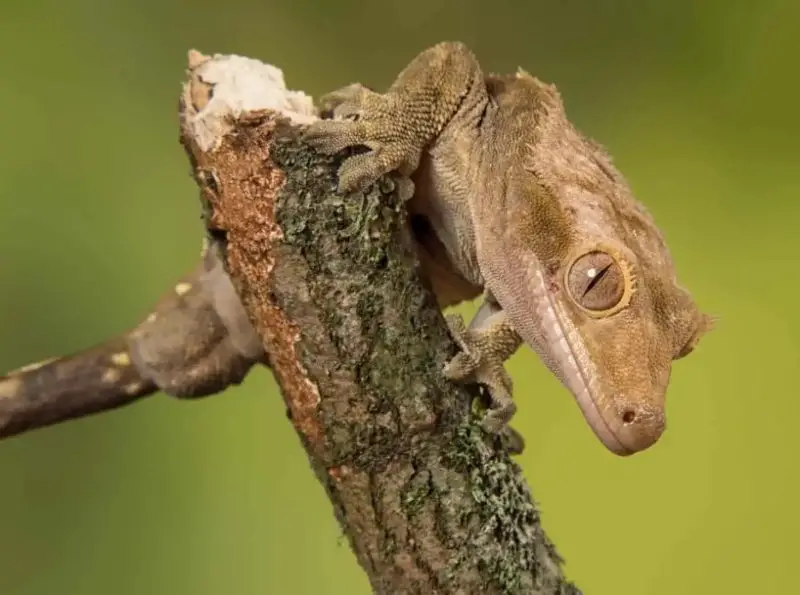Crested geckos, known for their striking appearance and gentle nature, have become popular pets worldwide. These nocturnal reptiles are native to New Caledonia, where they thrive in a humid, tropical climate. To ensure your crested gecko remains healthy and active, maintaining the right humidity level is crucial.
This comprehensive guide provides essential tips and insights on managing crested gecko humidity for an optimal living environment.
Why Is Humidity Important for Crested Geckos?

Humidity plays a vital role in the well-being of crested geckos. In their natural habitat, humidity levels range between 60% and 80%. This moisture-rich environment supports their respiratory health, skin shedding, and hydration. If the humidity is too low, crested geckos may experience dehydration, shedding issues, and respiratory problems. Conversely, excessively high humidity can lead to mold growth and bacterial infections. Striking the right balance is key to ensuring your pet’s health and comfort.
Effects of Low Humidity
Low humidity levels can cause significant health issues for crested geckos. One common problem is dehydration, which may manifest as wrinkled skin, sunken eyes, and lethargy. Inadequate humidity also leads to shedding complications, where patches of old skin remain stuck, particularly around the toes and tail. If not addressed promptly, this can restrict blood flow, resulting in infections or even limb loss.
Low humidity also impacts respiratory health. Dry air irritates the gecko’s sensitive respiratory system, increasing the risk of respiratory infections. Additionally, inadequate humidity can make the gecko feel stressed, affecting its appetite and overall activity levels.
Effects of High Humidity
While low humidity poses risks, excessively high humidity is equally problematic. Constantly damp conditions encourage mold growth, harmful bacteria, and fungi within the enclosure. This can lead to respiratory infections, characterized by wheezing, nasal discharge, and labored breathing.
High humidity also contributes to skin infections, as bacteria thrive in moist environments. These infections can cause redness, swelling, and discomfort for the gecko. Maintaining balanced humidity levels helps prevent these issues, ensuring a healthy environment.
Ideal Humidity Levels for Crested Geckos
The optimal humidity range for crested geckos is between 60% and 80%. During the day, it is recommended to maintain a humidity level of around 60-70%. This lower range mimics their natural environment and prevents excessive moisture buildup. At night, humidity can be increased to 80%, simulating the cooler, more humid conditions of their native habitat.
Daytime Humidity Levels
During the day, maintaining humidity levels between 60% and 70% is ideal. This range replicates the natural daytime climate of New Caledonia, where crested geckos originate. Daytime humidity should not be too high, as excessive moisture can encourage mold and bacteria growth.
A light misting in the morning can help achieve the desired daytime humidity. It also provides water droplets on the leaves and enclosure walls, allowing the gecko to drink. Avoid heavy misting during the day, as it may create overly damp conditions.
Nighttime Humidity Levels
At night, humidity levels can be safely increased to around 80%. This mirrors the natural nighttime environment in the gecko’s habitat, where humidity rises as temperatures drop. A heavier misting in the evening helps achieve this, promoting hydration and supporting the shedding process.
Maintaining higher humidity at night is particularly beneficial for geckos experiencing shedding difficulties. The increased moisture softens the old skin, making it easier for the gecko to shed naturally.
How to Measure Humidity in the Enclosure
Accurate humidity measurement is crucial for maintaining a healthy environment for your crested gecko. Hygrometers are essential tools for this purpose. There are two main types of hygrometers: analog and digital.
Analog vs. Digital Hygrometers
Analog hygrometers are affordable and straightforward to use but may not always provide precise readings. They often require manual calibration and can become less accurate over time. However, they are a budget-friendly option for beginners.
Digital hygrometers offer greater accuracy and often come with additional features like temperature monitoring. These devices provide more reliable readings and usually have an easy-to-read display. Some digital models also store humidity data, allowing you to track fluctuations over time.
Placement of Hygrometers
For best results, place the hygrometer in the middle of the enclosure, away from direct water sprays, to get an accurate reading of the overall humidity level. Placing the device too close to the misting area can lead to false high readings, while positioning it near a ventilation source may indicate lower humidity levels than the gecko actually experiences.
For larger enclosures, consider using multiple hygrometers at different locations to monitor humidity variations. This approach ensures a balanced environment throughout the habitat, allowing you to adjust misting and ventilation as needed.
Creating and Maintaining Humidity
To create and maintain the right humidity levels, a combination of misting, substrate choice, and proper ventilation is necessary.
Misting Techniques
Misting is the most straightforward method for increasing humidity. Using a spray bottle, lightly mist the enclosure twice daily, ensuring that water droplets form on the plants and enclosure walls. This not only raises the humidity but also provides drinking water for the gecko, as they prefer to lick moisture off surfaces.
For those seeking a more automated solution, a misting system or humidifier can be used. Misting systems are programmable, allowing you to set specific times for spraying. This feature ensures consistent humidity levels, especially for busy pet owners. Humidifiers, when used with a timer, can also maintain stable humidity without excessive wetness.
Choosing the Right Substrate
The choice of substrate plays a significant role in humidity retention. Coconut fiber, cypress mulch, and sphagnum moss are excellent options as they hold moisture well. These substrates naturally release moisture over time, helping maintain stable humidity levels.
When choosing a substrate, ensure it is safe and free from harmful chemicals or pesticides. Avoid substrates with artificial scents or dyes, as they can be toxic to reptiles. Regularly check and replace the substrate to prevent mold growth and maintain cleanliness.
Importance of Proper Ventilation
Proper ventilation is equally important. Enclosures with good airflow prevent mold buildup while allowing moisture to circulate effectively. A screen-top enclosure provides ample ventilation while retaining enough humidity, especially when combined with misting.
However, too much ventilation can cause humidity to drop quickly. To counter this, partially cover the screen top with a plastic sheet or foil, leaving enough space for airflow. This method helps maintain the desired humidity levels while preventing excessive moisture loss.
Using Live Plants for Natural Humidity
Placing live plants in the enclosure can naturally increase humidity while enhancing the aesthetic appeal. Plants like pothos, bromeliads, and philodendrons are safe for crested geckos and thrive in humid conditions. These plants release moisture through transpiration, contributing to a balanced humidity level.
Live plants also provide hiding spots and climbing areas, enriching the gecko’s environment. Ensure the plants are non-toxic and free from pesticides or fertilizers. Regularly water the plants to maintain their health and support humidity.
Using Water Dishes Strategically
Strategically placing water dishes near heat sources can subtly increase humidity. As the water evaporates, it adds moisture to the air, helping maintain consistent humidity levels. Use shallow dishes to prevent drowning risks and change the water daily to ensure cleanliness.
This method works particularly well in combination with misting and live plants, creating a balanced microclimate within the enclosure.
Humidity Control with Humidifiers and Foggers
Humidifiers and foggers are effective tools for maintaining consistent humidity levels in crested gecko enclosures. These devices provide a steady supply of moisture, ensuring a stable environment even in dry climates or air-conditioned rooms.
Humidifiers release a fine mist into the air, raising humidity without soaking the substrate or enclosure walls. Ultrasonic humidifiers are particularly effective as they produce a cool mist, preventing temperature fluctuations. Connect the humidifier to a hygrometer with a built-in controller for automatic adjustments based on the current humidity level.
Foggers create a misty atmosphere, closely resembling the natural habitat of crested geckos. They enhance the enclosure’s visual appeal while providing necessary humidity. However, use foggers sparingly, as excessive fog can reduce visibility and potentially stress the gecko.
When using humidifiers or foggers, ensure proper ventilation to avoid moisture buildup, which can lead to mold growth and respiratory issues.
Avoiding Common Humidity Mistakes
Maintaining the correct humidity requires careful monitoring and adjustments. Here are common mistakes to avoid:
Over-Misting and Constant Dampness
One common mistake is over-misting, which can lead to consistently high humidity levels, promoting mold growth and respiratory issues. It is essential to allow the enclosure to dry out partially between misting sessions. This cycle mimics natural conditions and helps maintain the recommended humidity range.
To avoid over-misting, observe the enclosure’s drying time and adjust the misting schedule accordingly. If condensation remains visible for extended periods, reduce the frequency or amount of misting.
Inadequate Ventilation
Neglecting ventilation can create a stagnant, overly humid environment, leading to mold and bacterial growth. An enclosure that is too tightly sealed will trap moisture, creating unhealthy living conditions for your gecko.
Ensure sufficient airflow by using screen-top enclosures or incorporating ventilation holes. If using a glass or plastic enclosure, partially cover the top to retain humidity while leaving enough space for air circulation.
Inaccurate Humidity Readings
Using old or malfunctioning hygrometers can provide misleading data, leading to improper humidity adjustments. Regularly check and calibrate your hygrometer to ensure accurate readings. Replace batteries in digital hygrometers periodically to maintain functionality.
For accurate monitoring, use multiple hygrometers at different heights and locations within the enclosure. This approach helps detect humidity variations and provides a comprehensive understanding of the overall environment.
Choosing Inappropriate Substrates
Using the wrong type of substrate can cause humidity problems. Avoid substrates that dry out too quickly or those that retain too much moisture. Sand and gravel are poor choices, as they provide minimal humidity retention. Instead, use moisture-absorbing substrates like coconut fiber, sphagnum moss, or cypress mulch.
Change the substrate regularly to prevent mold growth and bacterial buildup. If the substrate becomes overly damp, replace it promptly to maintain a healthy enclosure environment.
Signs of Improper Humidity
Crested geckos exhibit noticeable signs when humidity levels are unsuitable. Being aware of these symptoms can help you make timely adjustments to maintain a healthy environment.
Signs of Low Humidity
If the humidity is too low, crested geckos may show signs of dehydration, including:
- Wrinkled or sagging skin
- Sunken eyes
- Lethargy and reduced activity
- Loss of appetite
- Difficulty shedding, with old skin remaining stuck on toes or tail
Shedding issues are particularly problematic, as retained skin can constrict blood flow, leading to infections or loss of digits. If you notice stuck shed, increase humidity and provide a shedding aid, such as a moist hide or a gentle bath.
Signs of High Humidity
Excessive humidity can lead to respiratory infections and skin problems. Watch for the following symptoms:
- Wheezing or clicking noises while breathing
- Nasal discharge or bubbles
- Labored breathing
- Swollen or irritated skin
- Presence of mold or mildew in the enclosure
If respiratory symptoms occur, reduce humidity and increase ventilation. Consult a reptile veterinarian for a proper diagnosis and treatment.
Seasonal Changes and Humidity Adjustments
Seasonal changes can significantly impact indoor humidity levels, affecting your gecko’s habitat. Adapting to these fluctuations is crucial for maintaining optimal conditions.
Winter Humidity Challenges
During winter, indoor heating systems can cause dryness, reducing humidity. This can lead to dehydration and shedding issues for your crested gecko. To counter this:
- Increase misting frequency or use a humidifier.
- Cover part of the screen top with plastic wrap to retain moisture.
- Use moisture-retaining substrates like sphagnum moss or coconut fiber.
Monitor humidity levels more frequently during winter to ensure they remain within the recommended range.
Summer Humidity Adjustments
In summer, high ambient humidity may require less misting to avoid excessive moisture. To maintain balance:
- Reduce misting frequency or duration.
- Increase ventilation by uncovering more of the screen top.
- Monitor the enclosure for signs of mold or mildew.
Using fans near the enclosure (without blowing directly on the gecko) can improve airflow and reduce humidity if needed.
Cleaning and Maintenance Tips
Maintaining proper humidity goes hand in hand with regular cleaning. A clean enclosure minimizes the risk of mold, bacteria, and parasites thriving in a humid environment.
Weekly Cleaning Routine
- Remove uneaten food and waste daily to prevent bacterial growth.
- Wipe down the enclosure walls and decorations to remove water spots and mold spores.
- Replace water dishes with fresh, clean water daily.
Monthly Deep Cleaning
- Remove all accessories, including plants and hides.
- Disinfect the enclosure with reptile-safe cleaning products.
- Rinse thoroughly to remove any chemical residue.
- Replace the substrate entirely to prevent mold or bacterial buildup.
Ensure all items are completely dry before placing them back in the enclosure to avoid excessive humidity.
Conclusion: Achieving the Perfect Humidity Balance
Maintaining the ideal humidity for crested geckos is essential for their health and happiness. By understanding the importance of humidity, using reliable measuring tools, and implementing effective methods such as misting, proper substrate choice, and ventilation, you can create a thriving environment for your pet.
Creating the perfect environment for your crested gecko may require some adjustments and experimentation, but the effort is worth it. With the right humidity management, your gecko will thrive, showcasing vibrant colors, healthy shedding, and active behavior.
A balanced approach, regular monitoring, and proactive adjustments are the keys to maintaining optimal crested gecko humidity. By doing so, you provide a comfortable and healthy habitat that allows your pet to flourish.






